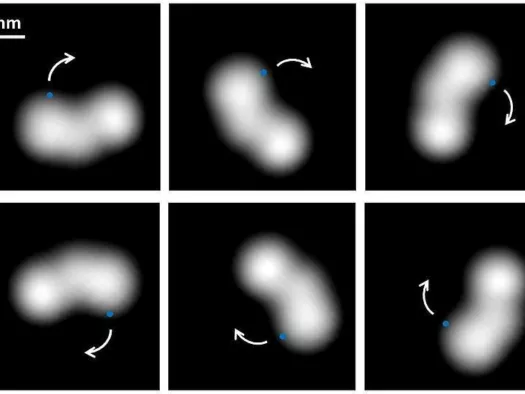LEONHARD GRILL GOT THE MOLECULE ROLLING
WHAT IF WE COULD MOVE MOLECULES TO WHEREVER WE WANT THEM?
Molecules are the basic building blocks of life. That’s why so many scientists are conducting research into what might be possible with them. Experimental physicist Leonhard Grill is one such researcher – and he’s made an earth-shattering discovery.
Grill, a professor at the University of Graz in Austria, conducts research into functional molecules, the latter being particles that consist of several atoms. “It’s an interesting subject,” he says – which is something of an understatement, given the enormous importance that molecules have as the tiny particles that everything around us is made up of.
Research on molecules and on molecular machines – that is, molecules that can perform specific tasks – is therefore equally important – and Grill is one of the experts in this field. In 2007, he successfully carried out an experiment in this very area of research, managing to make a single molecule roll on a surface in a controlled manner.
HOW DID THE EXPERIMENT SUCCEED?
Normally, molecules jump over very small distances from one point within the crystal lattice of a surface to another, typically driven by thermal energy. Grill, however, managed to make a molecule roll by “manipulating” it with a scanning tunnelling microscope (STM). The researchers analysed the current signal from the microscope until they detected the pattern of a rolling motion. “We simply had to keep on trying until we found the molecule that was exactly right for our purpose,” says Grill.“Initially, we experimented with molecules with different structures. Ironically, it was the smallest and simplest of all molecules that worked.” While Grill remained cautious, the press immediately flew into a frenzy. “Professor makes molecular wheels roll”, “Nano-wheels are able to roll” or “Nanotechnology reinvents the wheel” were among the jubilant headlines.
WHAT POSSIBILITIES HAVE THESE FINDINGS OPENED UP?
To Grill, the potential applications resulting from his successful experiment mattered much more than the press coverage. He says: “Perhaps rolling molecules move differently over surfaces than jumping ones, perhaps they’re even able to overcome obstacles, for example – but on the atomic scale, of course! In addition, colleagues from the field of synthetic chemistry have in recent decades developed more advanced products – such as molecular motors.” These motors deactivate something that’s called microscopic reversibility – namely the basic principle according to which process A is always accompanied by process B, which runs in the opposite direction. If this principle is neutralised, a side arm of the molecule, for example, will rotate in only one direction in the fashion of a propeller. The molecule’s side arms no longer move in both directions. If they’re on a surface, such molecules are now able to set off in a certain direction.The 2016 Nobel Prize for Chemistry was awarded to three researchers from France, Great Britain and the Netherlands for “nanomachines” made of molecules such as the ones described. “And we might be able to do much more with them,” explains Grill. “Just imagine if we were able to use light to simultaneously control a large number of molecules – and, for example, even have them transport something.”
IS THERE A DATE FOR WHEN THIS COULD BE MADE TO HAPPEN?
Grill uses an example to explain how significant such an occurrence would be: “When you take an aspirin pill, the active ingredient spreads throughout the body and eventually reaches the areas it’s supposed to reach in order for it to have an effect.” If it were possible by means of molecular motors to lay down where the active ingredient is to move to, and at what point in time certain mechanical molecular processes are to be triggered, then it might be possible to make the active ingredient work better and faster.“That would be an incredible development, a huge step forward,” says Grill. “Initial experiments by our cooperation partner James Tour have shown that molecular machines can drill holes in cell membranes by means of their specific mechanical movement.” Another idea would be to have molecular motors transport individual atoms, thereby creating very small structures, that is, a targeted “bottom-up” construction. However, it will still take some time before it’s possible to control the molecules precisely and to move them to the right destinations: “It’s just not possible to give a time scale at this point,” says Grill and adds: "We know what our final goal is, we know our destination – but it’s not yet clear how we can get there.”

A single molecule can be rotated in a targeted way: researchers at the University of Graz, Austria, have developed a mini rotor.
Photo: L. Grill (University of Graz) taken from Grant Simpson et al, Nature Communications 10, 4631 (2019)